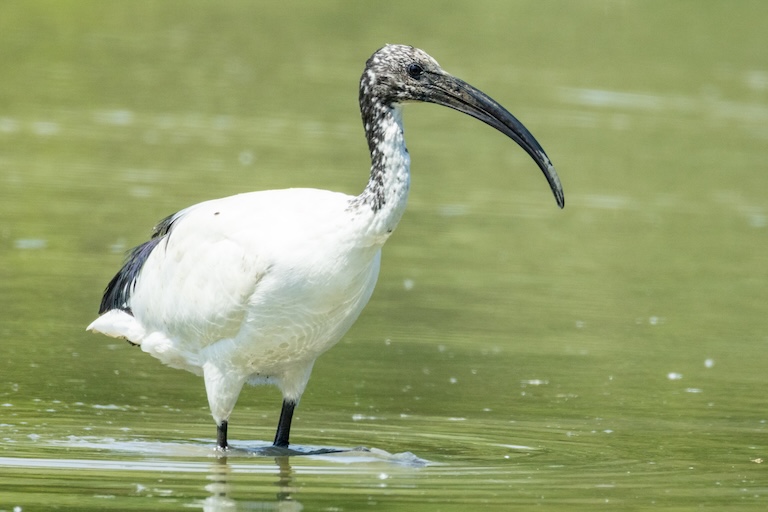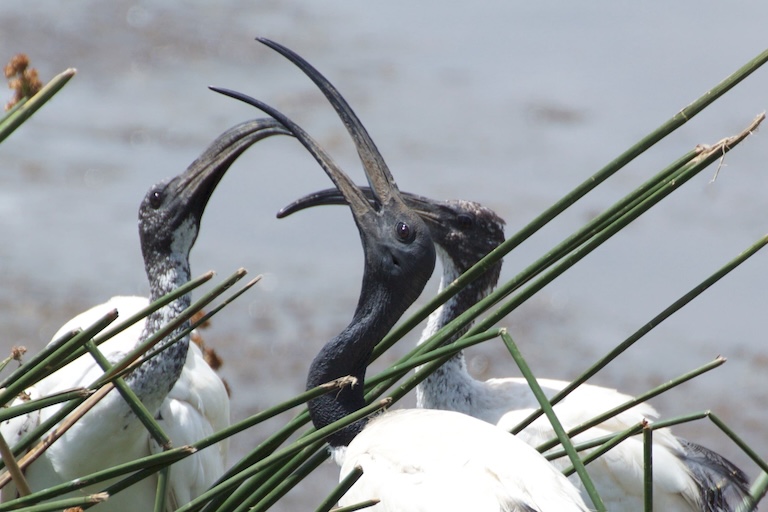African Sacred Ibis Profile
Ancient Egypt depicted the god Toth, a sort of scholar-type responsible for knowledge and writing, in the form of a large and scruffy bird now known as the sacred ibis.
At first glance, it might be weird to have such a dishevelled animal held in as high regard as this, and it’s likely that the unconscionable and infinitely more obnoxious hadada ibis deified this bird purely from a relativistic standpoint.
But on closer inspection, the sacred ibis is quite a lovely bird, and its quiet contemplation fits perfectly with the image of the scribe of the gods.

African Sacred Ibis Facts Overview
| Habitat: | Varied, near water |
| Location: | Most of Africa, in Iran, Iraq, and Yemen; introduced to Europe and Japan |
| Lifespan: | 20 |
| Size: | 68 cm (27 in) long |
| Weight: | Up to 1.5 kg (3.3 lb) |
| Colour: | White body, black rump, legs and head. |
| Diet: | Mostly invertebrates, as well as fish, frogs, reptiles, small mammals and carrion |
| Predators: | African fish eagle, |
| Top Speed: | 38.4 kph (23.9 mph) |
| No. of Species: | 1 |
| Conservation Status: | Least Concern |
Sacred Ibises are from a time when humility and gentle grace were the desirable characteristics of human societies. They’re elegant birds, with a very wide range, and have been introduced to various parts of other continents like Asia and Europe.
They’re well known from ancient Egyptian history, having been mummified in rituals that signify their importance to the cultures of the time, yet, curiously, this species is now absent from the region.
Still, they are thriving across the continent and elsewhere, and their global population is thought to be stable.
Interesting African Sacred Ibis Facts
1. They’re Threskiornithids!
Don’t worry, nobody else can pronounce that, either. The Threskiornithidae family is a group of birds in the so-called Pelecaniformes order of mostly water birds, and this family contains all the ibises and spoonbills.
There are around 40 species in this family, and they’re known for their long wings and beaks, allowing them to soar and probe for food in wetlands, respectively.
Ibises are egret-like wading birds, making up thirteen genera of often brightly coloured (and sometimes cartoonishly-so, as in the scarlet ibis), bald-headed birds good at rummaging through things.
Of all of these, the sacred ibis is one of the least colourful, choosing to go with the dirty white plumage as a juvenile and cleaning up a bit into a simple black-and-white bird in adulthood.
But it’s unlikely that their looks are what gave them their popularity in ancient cultures. 1

2. They’re elegant
One of the sacred ibis’ closest relatives is the similarly-looking Australian white ibis, which if the nickname “bin chicken” is anything to go by, is decidedly less revered.
But despite cultural attitudes toward these two birds being more or less opposable, the pair have a lot in common.
Both of these birds are generally peaceful animals, long-legged and gentle in their demeanour (unless you’re a prey item), but the Australian equivalent is considered smelly and messy, which is a bit hypocritical, considering it’s the humans who made the mess it’s eating.
The bin chicken is also named because it has adapted to live in the urban environment, able to sift through human refuse to find nuggets of food.
The sacred ibis, too, eats almost anything proteinous that it can come across, and this is also what keeps the sacred ibis in business halfway across the world.
3. They’re not fussy eaters
These graceful animals are typically predators of insects, worms and crustaceans, which they attack in flocks, marching through the land, and probing into the substrate with their elongated beaks.
But they’ll also eat anything else they can find, including fish, frogs, and even carrion. It seems as though it’s only vegetables this bird won’t eat, which still gives it a very varied diet, and allows it to live almost anywhere there are small animals.
For example, some populations were found to eat mostly frogs, while in other locations, they ate mostly crayfish. 2
4. They’re no longer found in Egypt
The Egyptians cemented this bird into human culture as far back as 1100 BC, and after that, they` started sacrificing them in their millions.
This unusual relationship with the poor bird manifests in the millions (literally, around 8 million!) of mummified sacred ibises found by archaeologists in Egypt.
But the strange thing is, there are no longer any such birds in Egypt. Perhaps given the sheer number of mummified corpses they found, it’s not strange at all, but it’s more likely that the climate of the time was far more comfortable for the bird to live in than it is now.
Still, to keep up with the incredible demand for ibis sacrifices, it’s thought that ibis farming would have been necessary. 3

5. They’re quiet
The sacred ibis inhabits a lot of land that overlaps with the range of its close relative, the Hadada ibis.
The latter, as we have commented before, is the worst bird in the world, on account of it drawing you in with its beautiful iridescent green plumage and then making you sick with its grotesque and deafening call.
Hadada ibises are the Jennifer Lopez of the bird world, and in stark contrast, the gentle, puppy-like sounds that come from the sacred ibis make you wonder why this had to be the species the Egyptians killed en mass. 4
6. They migrate
Breeding grounds for this species can be as far North as Iraq, and some migrate 1,500 km to reproduce. Northern populations migrate South to avoid the rains, and Southern populations migrate North, one particular example being those from South Africa embarking on the long journey to ride out the weather in Zambia.
7. They have a very wide range
All this moving about gives the bird a very wide range, and Africa is so big that a species can never leave the continent and still have a wider range than most other animals.
This bird isn’t just found in mainland Africa, but also in Madagascar, Iran, Iraq, and Yemen. Ironically, Egypt seems to be one of the only places you can’t find this species, but you can hardly blame them for that.

African Sacred Ibis Fact-File Summary
Scientific Classification
| Kingdom: | Animalia |
| Phylum: | Chordata |
| Class: | Aves |
| Order: | Pelecaniformes |
| Family: | Threskiornithidae |
| Genus: | Threskiornis |
| Species: | aethiopicus |
Fact Sources & References
- Scope TV (2020), “Are Ibises Sacred (Or Just Bin Chickens?)”, YouTube.
- Charlie Ramsey “Threskiornis aethiopicus sacred ibis”, Animal Diversity Web.
- Caitlin Curtis (2018), “The Sacred Ibis debate: The first test of evolution”, PubMed Central.
- Hawk Conservancy Trust (2015), “The Sacred Ibis”, YouTube.
